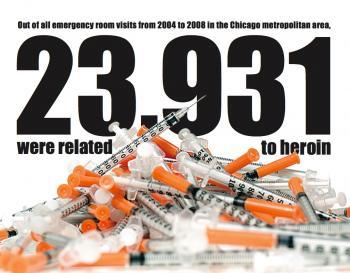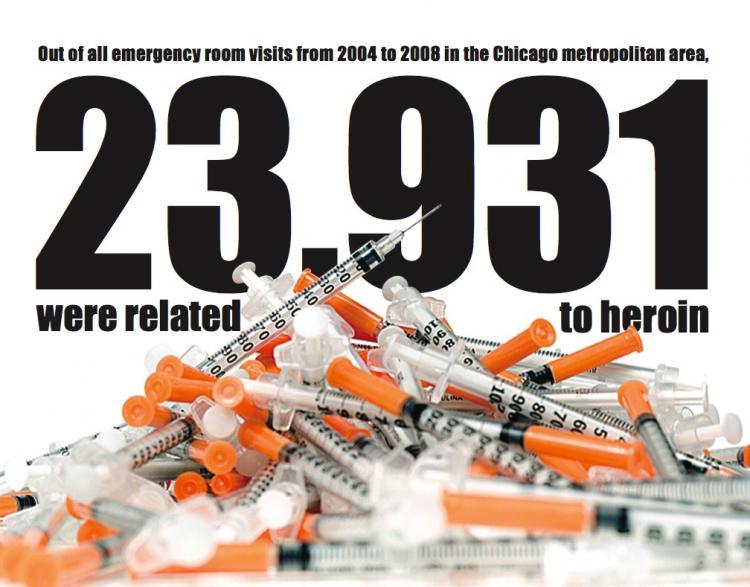CHICAGO—The highest concentration of heroin abuse from across the nation can be found in and around Chicago, according to a recent study.
The report, released earlier this week from the city’s own Roosevelt University, finds that there are more emergency room visits and problems related to heroin in Chicago and its surrounding suburbs than anywhere else in the United States.
From 2004 to 2008, the Chicago metropolitan area, which includes Cook and neighboring counties, had the most cases of heroin-related emergency room visits found anywhere—an enormous 23,931 cases in all. During this period, Chicagoland (metropolitan Chicago area) handled 50 percent more cases than New York City, which ranked second, according to an analysis of data from the Drug Abuse Warning Network (DAWN).
The new report, “Heroin Use in Illinois: A Ten Year Multiple Indicator Analysis—1998 to 2008,” found that more Illinois residents seek substance abuse treatment for heroin than for any other illegal substance.
“It’s a problem that goes beyond the city of Chicago, into the suburbs and outlying areas, and for the first time, we have a clearer idea of who in our communities is using heroin,” said Kathleen Kane-Willis, coauthor of the report, in a press release.
Urban heroin users in Chicago were mostly African-American and over 21 years old. Suburban heroin users had different demographics; many were white and young. Many were teens and young adults up to 24 years old, according to the report.
Researchers said that the staggering numbers of heroin cases in the Chicago area are overwhelming Illinois’ public treatment system. Meanwhile, nearly 29 percent of those arrested in Cook County tested positive for heroin in 2008—more than double the rate of arrestees testing positive for the drug in Washington, D.C., which ranked second.
The numbers related to heroin abuse only seem to be growing. The Chicago Police Department reported a 50 percent increase in the number of arrests for heroin from 2008 to 2009.
Researchers found troubling evidence that heroin overdoses are on the rise in the region’s collar counties. Area medical examiners reported a 130 percent increase in heroin deaths in Lake County between 2000 and 2009, a 150 percent increase in deaths in McHenry County in the last three years, and a doubling of deaths in Will County in two years’ time.
While these numbers paint a grim picture for heroin use for the Chicago metropolitan area, researchers did find some encouraging evidence. Deaths from heroin overdoses in Cook County fell 16 percent during the last decade, an improvement the researchers say was possible thanks to a new state law allowing doctors to prescribe naloxone, a drug that reverses the effects of overdoses from opiates and heroin, and the work of one group, a needle exchange program in Chicago and Cook County called the Chicago Recovery Alliance, which has prescribed the overdose-reversal drug and has trained thousands how to use it in an emergency since 2001.
The report called for a variety of programs to improve Illinois’s heroin problem, including heroin education for youth detailing the impact of its use, an increase in treatment funding, increased availability of syringes, and more awareness about syringe access laws. Sharing syringes is a potentially deadly practice that can spread hepatitis, HIV, and other pathogens.
Researchers added that limited protection for 911 callers reporting drug overdoses could save lives. This has been a controversial proposal and has not been made legal in Illinois to date. There have been fears that drug dealers could be granted immunity from prosecution if they called 911. However, the study recommends prosecutors, Illinois lawmakers and treatment advocates come together to craft a law that will provide limited immunity to callers who might be able to prevent drug overdose deaths.
“We need more programs like this in our outlying areas if we are to get a handle on what is becoming a heroin epidemic,” Kane-Willis said in a statement.
The report, released earlier this week from the city’s own Roosevelt University, finds that there are more emergency room visits and problems related to heroin in Chicago and its surrounding suburbs than anywhere else in the United States.
From 2004 to 2008, the Chicago metropolitan area, which includes Cook and neighboring counties, had the most cases of heroin-related emergency room visits found anywhere—an enormous 23,931 cases in all. During this period, Chicagoland (metropolitan Chicago area) handled 50 percent more cases than New York City, which ranked second, according to an analysis of data from the Drug Abuse Warning Network (DAWN).
The new report, “Heroin Use in Illinois: A Ten Year Multiple Indicator Analysis—1998 to 2008,” found that more Illinois residents seek substance abuse treatment for heroin than for any other illegal substance.
“It’s a problem that goes beyond the city of Chicago, into the suburbs and outlying areas, and for the first time, we have a clearer idea of who in our communities is using heroin,” said Kathleen Kane-Willis, coauthor of the report, in a press release.
Urban heroin users in Chicago were mostly African-American and over 21 years old. Suburban heroin users had different demographics; many were white and young. Many were teens and young adults up to 24 years old, according to the report.
Researchers said that the staggering numbers of heroin cases in the Chicago area are overwhelming Illinois’ public treatment system. Meanwhile, nearly 29 percent of those arrested in Cook County tested positive for heroin in 2008—more than double the rate of arrestees testing positive for the drug in Washington, D.C., which ranked second.
The numbers related to heroin abuse only seem to be growing. The Chicago Police Department reported a 50 percent increase in the number of arrests for heroin from 2008 to 2009.
Researchers found troubling evidence that heroin overdoses are on the rise in the region’s collar counties. Area medical examiners reported a 130 percent increase in heroin deaths in Lake County between 2000 and 2009, a 150 percent increase in deaths in McHenry County in the last three years, and a doubling of deaths in Will County in two years’ time.
While these numbers paint a grim picture for heroin use for the Chicago metropolitan area, researchers did find some encouraging evidence. Deaths from heroin overdoses in Cook County fell 16 percent during the last decade, an improvement the researchers say was possible thanks to a new state law allowing doctors to prescribe naloxone, a drug that reverses the effects of overdoses from opiates and heroin, and the work of one group, a needle exchange program in Chicago and Cook County called the Chicago Recovery Alliance, which has prescribed the overdose-reversal drug and has trained thousands how to use it in an emergency since 2001.
The report called for a variety of programs to improve Illinois’s heroin problem, including heroin education for youth detailing the impact of its use, an increase in treatment funding, increased availability of syringes, and more awareness about syringe access laws. Sharing syringes is a potentially deadly practice that can spread hepatitis, HIV, and other pathogens.
Researchers added that limited protection for 911 callers reporting drug overdoses could save lives. This has been a controversial proposal and has not been made legal in Illinois to date. There have been fears that drug dealers could be granted immunity from prosecution if they called 911. However, the study recommends prosecutors, Illinois lawmakers and treatment advocates come together to craft a law that will provide limited immunity to callers who might be able to prevent drug overdose deaths.
“We need more programs like this in our outlying areas if we are to get a handle on what is becoming a heroin epidemic,” Kane-Willis said in a statement.







